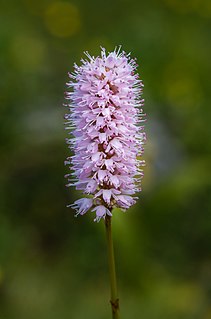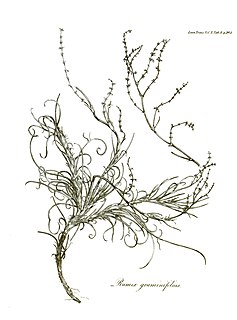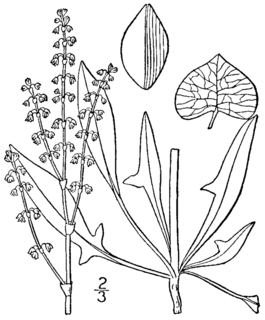
Bistorta officinalis, known as bistort, common bistort, European bistort or meadow bistort, is a species of flowering plant in the dock family Polygonaceae native to Europe and northern and western Asia. Other common names include snakeroot, snake-root, snakeweed and Easter-ledges.

The docks and sorrels, genus Rumex, are a genus of about 200 species of annual, biennial, and perennial herbs in the buckwheat family, Polygonaceae. Members of this genus are very common perennial herbs with a native almost worldwide distribution, and introduced species growing in the few places where the genus is not native.

Vallisneria is a genus of freshwater aquatic plant, commonly called eelgrass, tape grass or vallis. The genus is widely distributed in tropical and subtropical regions of Asia, Africa, Europe, and North America.

Taxodium distichum is a deciduous conifer in the family Cupressaceae. It is native to the southeastern United States. Hardy and tough, this tree adapts to a wide range of soil types, whether wet, salty, dry, or swampy. It is noted for the russet-red fall color of its lacy needles.

Rumex obtusifolius, commonly known as bitter dock, broad-leaved dock, bluntleaf dock, dock leaf or butter dock, is a perennial plant in the family Polygonaceae. It is native to Europe, but is found on all temperate continents. It is a highly invasive species in some zones, resulting from its abundant seed dispersal, adaptability to reproduce, aggressive roots, ability to tolerate extreme climates, and hardiness.

Rumex longifolius, commonly known as the dooryard dock or northern dock, is a perennial species of plant in the genus Rumex.

Rumex maritimus, commonly called golden dock, bristle dock, or seashore dock, is an annual plant species of the genus Rumex. Rumex maritimus grows in Argentina, Burma, Canada, China, and the United States. It is native to Canada and most of the 48 states. The life span of Rumex maritimus is rarely biennial in moist environments. This herb belongs to the family Polygonaceae.

Rumex hypogaeus, commonly known in English as southern threecornerjack, devil's thorn, or double gee, is a herbaceous plant of the Polygonaceae. It is native in South Africa and is an invasive species in Australia, Texas in the USA & Pakistan.

Rumex hydrolapathum, the great water dock, water dock, or giant water dock, is a species of perennial herbaceous plants in the genus Rumex native to fens and freshwater banks of Europe and Western Asia. It is the tallest species in the genus, with flowering stems attaining a height of up to 2 m. It is one of the small number of decaploid organisms, containing two hundred individual chromosomes.

Rumex graminifolius, common name grassleaf sorrel, is a species of the genus Rumex and the knotweed family Polygonaceae.
Rumex persicarioides is a flowering dicot species in the family Polygonaceae. This species flowers annually in the summer-time but on rare occasions it has been found to be biennial. R. persicarioides is not cultivated for human use and should not be confused with the similarly named genus Persicariae.

Rumex sanguineus, commonly known as bloody dock or red veined dock, is a perennial flowering plant species in the family Polygonaceae. Rumex sanguineus is a dicot and can be observed in Europe with at least two varieties

Rumex bucephalophorus, also known as horned, red, or ruby dock is an annual herbaceous plant that is part of the family Polygonaceae. The scientific name Rumex bucephalophorus was first described and published by Linnaeus in 1753 in Species Plantarum. Other scientific names have also been given to Rumex bucephalophorus such as Bucephalophora aculeata and Lapathum bucephalophorum. R. bucephalophorus is most commonly found in subcoastal or coastal regions, but also are "casual aliens", few and far between, among inland populations. Rumex bucephalophorus is native to the Mediterranean Basin and grows best in areas with little human intervention.

Rumex fueginus, known as American dock, golden dock, and Tierra del Fuego dock, is a flowering plant in the family Polygonaceae. Rumex fueginus was first formally named by Rodolfo Armando Phillipi. Rumex fueginus is native from Canada in northern North America to Tierra del Fuego at the southern tip of South America. It has previously been considered a subspecies or variety of Rumex maritimus, a Eurasian species.

Rumex hastatulus, commonly known as the heartwing sorrel, is an annual flowering plant species in the family Polygonaceae otherwise known as the buckwheat family. It is found spread out through the eastern and southern United States.
Rumex utahensis is a flowering plant species in the family Polygonaceae. The common name for this species is Utah dock. It is a dicot, perennial herb that is native to the United states, growing only in the West.

Rumex occidentalis is a flowering plant species belonging to the family Polygonaceae. Commonly known as western dock, Rumex occidentalis can be found in parts of Western North America.
Rumex floridanus is a perennial flowering plant, in the family Polygonaceae. The common name for this species is Florida dock.

Rumex cuneifolius is a flowering plant species in the family Polygonaceae.
Rumex spiralis is a flowering plant commonly known as winged dock in the family Polygonaceae. This is a perennial herbaceous plant that is predominately native to southern Texas. This plant grows between 0–200 m in altitude.














